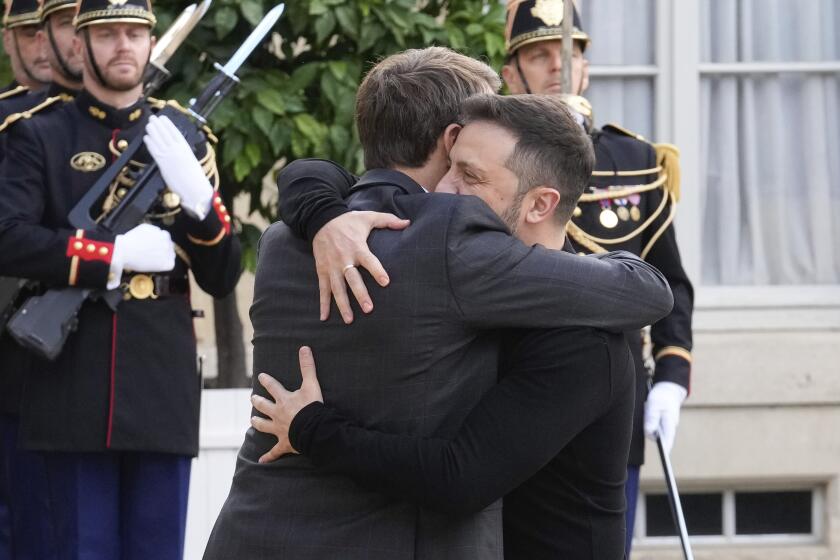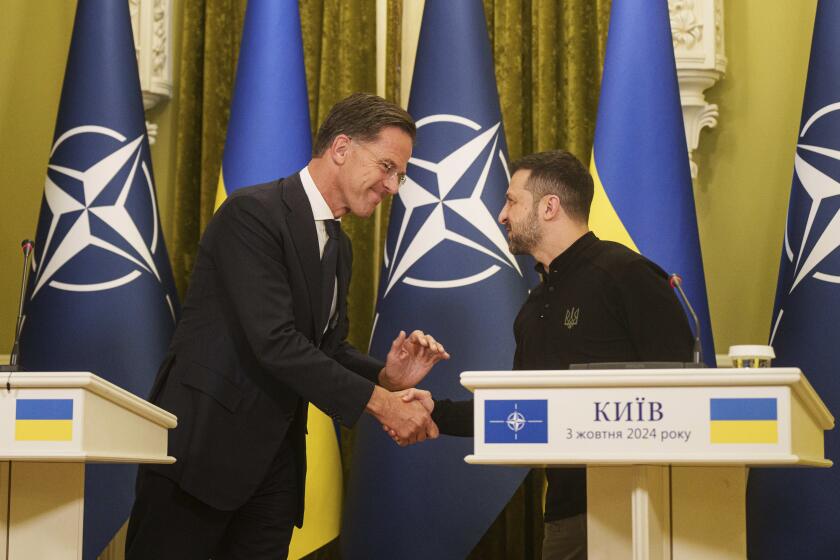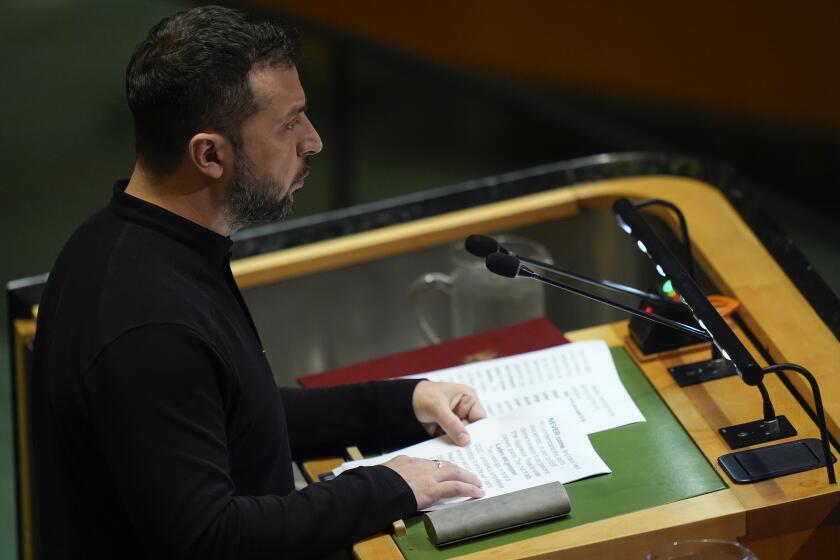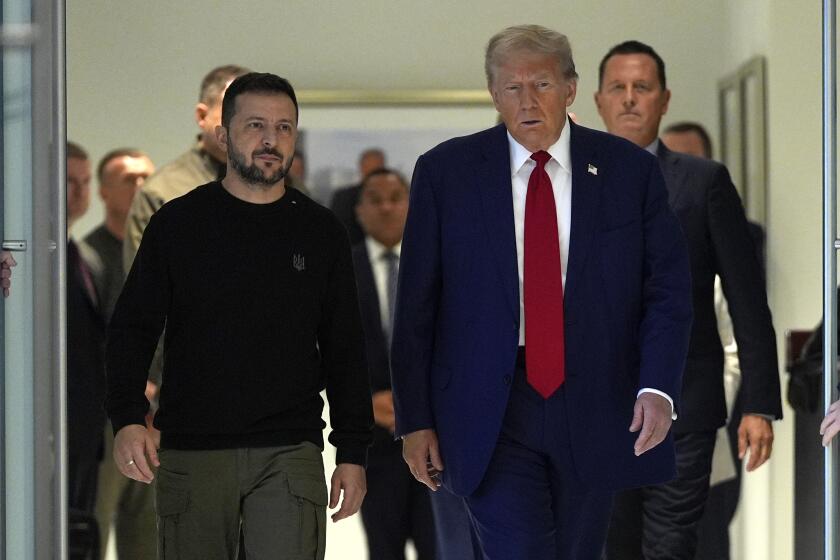Zelensky outlines his ‘victory plan’ to Ukraine’s lawmakers, including a call to join NATO

KYIV, Ukraine — President Volodymyr Zelensky told lawmakers Wednesday that Ukraine’s Western partners are increasing pressure to negotiate with Russia, but he hinted such talks would be unfavorable to Kyiv as he unveiled what he called his “victory plan” for the war.
Major points of the plan include an invitation for Ukraine to join NATO and permission to use Western-supplied longer-range missiles to strike military targets deep inside Russian territory — steps that have been met with reluctance by Kyiv’s allies so far.
“If we start moving according to this victory plan now, it may be possible to end the war no later than next year,” Zelensky told the Verkhovna Rada, the parliament. He will present the five-point plan to the European Council on Thursday.
Zelensky also said that in private communications with Ukraine, its partners are increasingly mentioning “negotiations” and much less frequently using the word “justice.”
But he reiterated that Ukraine is not prepared for a “frozen conflict” or any “trade-offs involving territory or sovereignty,” which drew sustained applause from the lawmakers.
Zelensky held talks with British Prime Minister Keir Starmer, NATO Secretary-General Mark Rutte, French President Emmanuel Macron and others.
As the war grinds through its third year, the mood in Ukraine is grim as its troops face difficulty holding back Russian advances, especially in the east. Although Moscow’s gains are incremental, the steady forward movement is making Kyiv feel it needs more large-scale Western help.
But there are signs that support may be hurt by the increasing focus on conflicts in the Middle East. The U.S. presidential election next month also could bring a major shift from Washington toward Ukraine.
Zelensky’s plan has been shrouded in secrecy as he outlined it to key allies including U.S. President Biden in recent weeks, and he did not mention some of its more confidential parts to the lawmakers.
The plan is seen as a way for Ukraine to strengthen its hand in any negotiations with Moscow. Besides the NATO invitation and seeking permission for the longer-range missile attacks, it includes continued military operations in Russia, such as the incursion into the Kursk border region that began in August.
Ukraine, he said, also needs more air defense systems and assistance from partners to shoot down Russian missiles. It also requested access to a broader range of intelligence from allies.
The new head of NATO, who has promised to help shore up Western support for Ukraine, pays a visit to the war-ravaged country.
Lawmakers will prioritize the bills needed to implement Zelensky’s plan, said Speaker Ruslan Stefanchuk after the speech. Stefanchuk said that while the issue of NATO membership is political, it also requires adopting laws to match the alliance’s standards.
Zelensky’s request for an invitation leaves NATO in a bind. Since the full-scale invasion began in 2022, NATO has struggled to find a way to bring Ukraine closer without formally inviting it in.
“We understand that NATO membership is a matter of the future, not the present,” Zelensky acknowledged. He reckons that such an invitation would alter President Vladimir Putin’s “geopolitical calculations.”
NATO Secretary-General Mark Rutte remained noncommittal after the plan was unveiled.
“We are in close contact with allies, with Ukraine, to see how we can take next steps,” Rutte told reporters at NATO headquarters in Brussels. He declined to provide details, saying: “I cannot give you all the insights about that.”
“We are working with the Ukrainians to understand better … how this would help in ending the war,” he said. For now, Rutte added, the focus must be to help Ukraine to win back more territory and strengthen its position for any future peace negotiations.
Ukraine President Volodymyr Zelensky urged world leaders at the U.N. to stand with his country and not seek ‘a lull’ instead of a ‘real, just peace.’
Zelensky said granting Ukraine an invitation to NATO would be a “testament of determination” by its allies to support Kyiv.
NATO’s collective security guarantee — Article 5 of its founding treaty — is the pillar on which its credibility is based. It is a political commitment by all member countries to come to the aid of any member whose sovereignty or territory might be under attack.
At their summit in Washington in July, NATO’s 32 members declared Ukraine to be on an “irreversible” path to membership. Any decision on offering to start membership talks is probably not likely before the next summit in the Netherlands in June.
Despite his attempts to win approval for the plan from Western partners, none have yet publicly voiced their support.
Lawmakers had a mixed reaction to Zelensky’s plan and whether it could be implemented.
“First of all, it’s not a plan. Plan means something with concrete steps,” said opposition lawmaker Oleksii Honcharenko. “It’s kind of a wish list from Ukraine for our partners, how they can and should support us. And it doesn’t look realistic. We were waiting for some real serious conversation about the situation and the strategy, and this is not that.”
He said that delivering a plan purported to be about victory as Russia advances in the east is “contradictory.”
Ukrainian President Volodymyr Zelensky and Donald Trump meet after the ex-president critiicizes U.S. support for Ukraine’s defense against Russia’s invasion.
Lawmaker Oleksandr Merezhko, from Zelensky’s party, called it “realistic and rather pragmatic,” adding: “It can be implemented if we have enough aid and support from our allies and partners.”
Kremlin spokesman Dmitry Peskov mocked it as “ephemeral,” and Russian Foreign Ministry spokeswoman Maria Zakharova called it “a set of incoherent slogans.”
In his speech, Zelensky also underscored his recent claim that North Korea is sending military personnel as well as ammunition to help Russia’s war effort, and that Iran and China also are aiding Moscow.
He noted that Ukraine is rich in natural resources, including critically important metals “worth trillions of U.S. dollars,” such as uranium, titanium, lithium, graphite and others.
Those assets, as well as the country’s agricultural production, are among Russia’s key targets in the war, he said, but could be shared with partners to boost each others’ economies. Similarly, battle-hardened Ukrainian troops would be an asset for NATO efforts to keep Russia at bay, Zelensky added.
Kullab and Arhirova write for the Associated Press. Associated Press writer Lorne Cook in Brussels contributed.
More to Read
Sign up for Essential California
The most important California stories and recommendations in your inbox every morning.
You may occasionally receive promotional content from the Los Angeles Times.














